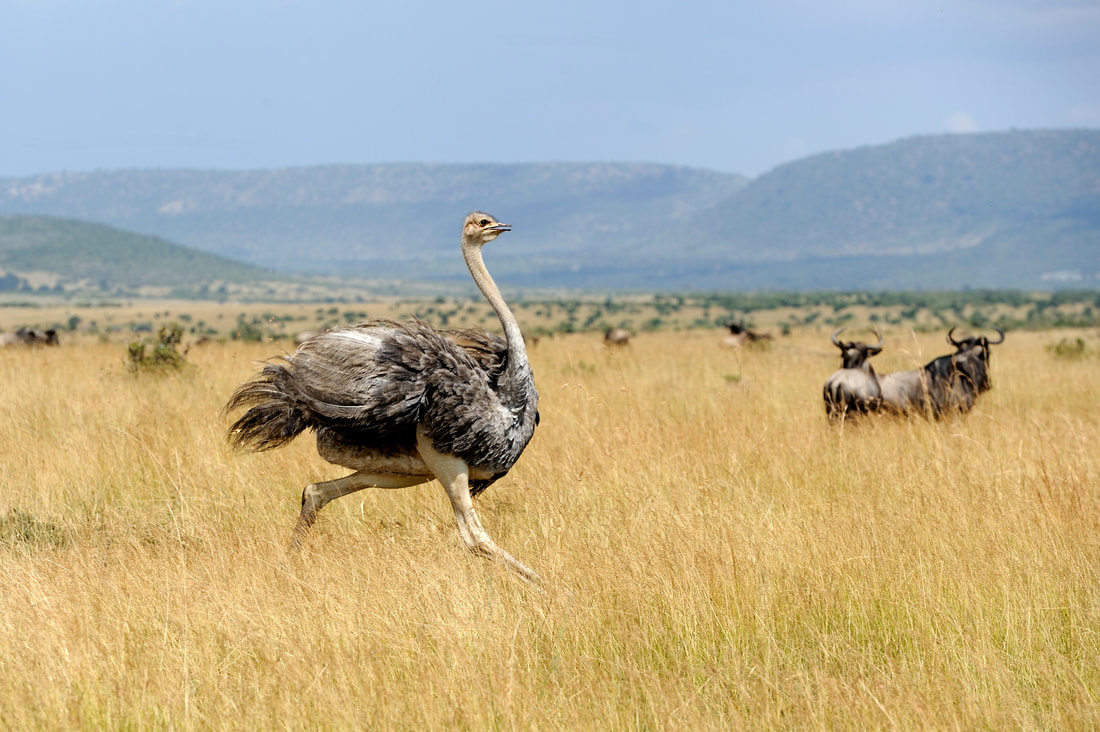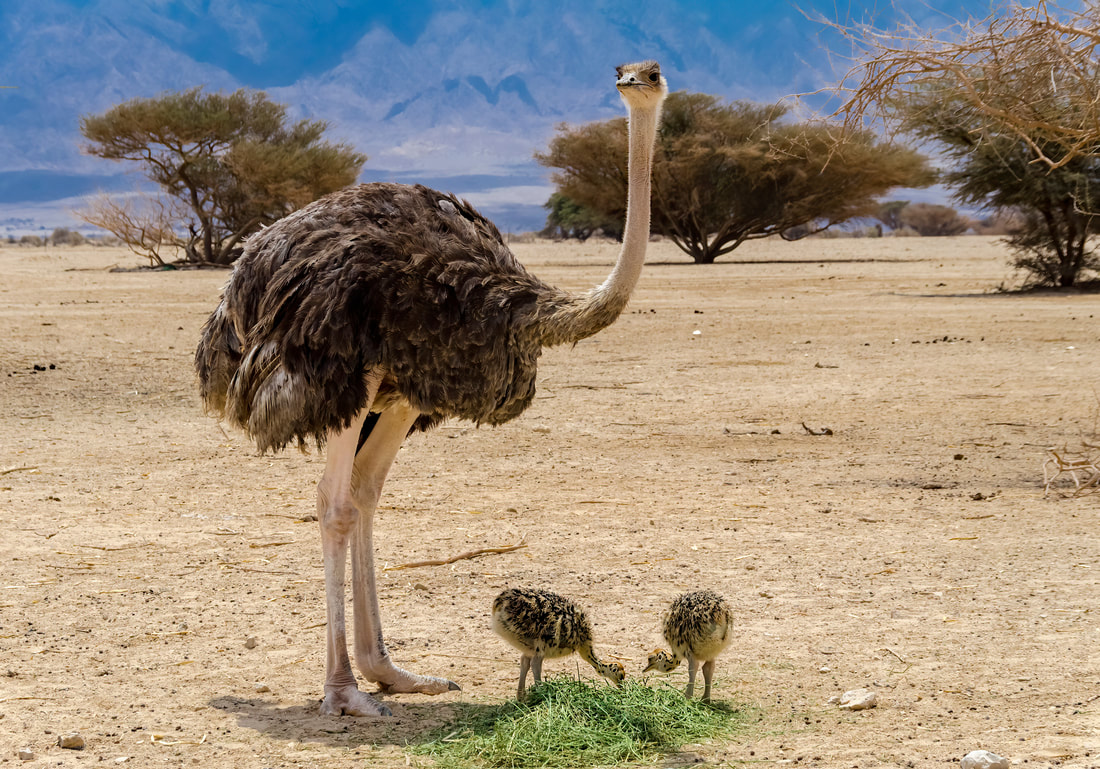Current Conservation Status For Ostriches:
Least Concern
|
SIZE
Height: 5.5-9ft Weight: 200-290lbs HABITAT & RANGE
Ostriches are most commonly found in northern Africa, from Morocco to Sudan, but can also be found in eastern and southern Africa. They are found only in semiarid and woodland country in Africa |
LIFESPAN
Wild Lifespan: 30-40 years Lifespan in Captivity: Up to 70 years DIET
Primarily vegetations ranging from grasses and shrubbery to berries and succulents. They eat some carnivorous foods, the majority of which are insects or small reptiles. They can also go without weather for long amounts of time |
PROS:
Ostriches are doing good things for the environment...
Ostriches are doing good things for the environment...
- Ostrich farming is more sustainable that your average livestock farming practices. It reduces strain on local water systems, which helps preserve and maintain balance of ecosystems.
- In their natural habitat, they have a mutually beneficial relationship with the animals around them. For example, they share feeding grounds with gazelles who in turn warn them of predators earlier than they would notice them on their own.
- Tourism allows wildlife foundations to keep ostriches in specific areas to bring money into the local community while also preventing land from overgrazing so it can support higher numbers of wildlife
CONS:
Ostrich conservation status is ranked as "least concern" , but they do face threats...
Ostrich conservation status is ranked as "least concern" , but they do face threats...
- Ostriches are used in some parts of Africa for entertainment, such as saddle racing, sulky racing, and and being ridden by tourists. Ostriches tire out easily, so all the racing weighs them down and wears on their body, leading to a short and painful life.
- Wild ostriches are being poached from their natural habitats. Their feathers are used in the fashion industry, meat and eggs for food, and fat for skincare products.
- Land in Africa continues to be developed for infrastructure, tourism, towns and farms. All this takes away from the land available for ostriches, which lowers their populations over time.
Ostrich Farming & Meat
Ostrich farming involves raising ostriches for their meat, feathers, and leather, which are all considered high-value products. Because they require less food and water, produce less methane, and can be raised in semiarid places, they're more eco-friendly to farm than most other kinds of livestock. The farming process can be done all around the world and includes breeding, hatching eggs in incubators, and raising the chicks. Ostrich farming is becoming more popular because of the demand for sustainable and alternative kinds of protein and other products.
More and more people are eating ostrich meat. It packs a punch with high protein, iron, and amino acids, while keeping fat and cholesterol on the low. It's a great alternative for traditional red meats and can be prepared similarly to beef. Plus, its flavor? Think lean beef but with a sweeter, fuller taste. It's catching on for those looking for healthier eats without skimping on taste or variety.
More and more people are eating ostrich meat. It packs a punch with high protein, iron, and amino acids, while keeping fat and cholesterol on the low. It's a great alternative for traditional red meats and can be prepared similarly to beef. Plus, its flavor? Think lean beef but with a sweeter, fuller taste. It's catching on for those looking for healthier eats without skimping on taste or variety.
The History Of Ostrich Leather
Ostrich leather has a pretty cool backstory. It dates back to ancient Egypt, where it was used because of its durability and unique texture. The Egyptians were all about luxury and longevity. It's known for those distinctive bumps, which are where the feathers were. Over time, this leather became a symbol of wealth across different cultures, making waves in the Roman Empire and later in European fashion. By the 19th and 20th centuries, it was all the rage in the fashion industry, being used for everything from boots to bags.
In more modern times, the use of Ostrich leather has been a bit rocky. It got its start in around 1850, but came to a near standstill when the first World War started. The demand came back after the war and even peaked in the 1980s, but trade sanctions led to the cartel taking over the industry, making it nearly impossible to get your hands on until apartheid ended in 1993.
Since 2000, ostrich leather has really found its niche in the high-end fashion market, being used by luxury brands and designers looking to offer something a bit different in everything from exclusive handbags and shoes to wallets and even furniture. It's all about that distinctive texture and durability, making it a sought-after material for those who want to blend tradition with a touch of exotic flair. Plus, with sustainability becoming a big conversation, ostrich farming and leather production have been highlighted for being relatively low-impact compared to other animal leathers.
In more modern times, the use of Ostrich leather has been a bit rocky. It got its start in around 1850, but came to a near standstill when the first World War started. The demand came back after the war and even peaked in the 1980s, but trade sanctions led to the cartel taking over the industry, making it nearly impossible to get your hands on until apartheid ended in 1993.
Since 2000, ostrich leather has really found its niche in the high-end fashion market, being used by luxury brands and designers looking to offer something a bit different in everything from exclusive handbags and shoes to wallets and even furniture. It's all about that distinctive texture and durability, making it a sought-after material for those who want to blend tradition with a touch of exotic flair. Plus, with sustainability becoming a big conversation, ostrich farming and leather production have been highlighted for being relatively low-impact compared to other animal leathers.
Want information on a specific species without waiting?
Conservation and ethical use is an incredibly important subject that deserves time and attention.
This informational section of our website is under constant construction and no information will be uploaded without intensive research into the topic/species first.
We understand you may want information on a certain species. Please keep in mind each species we utilize WILL be added to this page and we appreciate your patience while we gather accurate information for you.
*Source information will be listed when applicable
This informational section of our website is under constant construction and no information will be uploaded without intensive research into the topic/species first.
We understand you may want information on a certain species. Please keep in mind each species we utilize WILL be added to this page and we appreciate your patience while we gather accurate information for you.
*Source information will be listed when applicable
teton leather LLC
|
|
Copyright © 2015



